


Expanding The Scope
Sullivan's history as a matte painter goes back to the mid 80's, where he spent time at Dream Quest Images and Industrial Light & Magic before founding Compound Eye. He, like Tippett, was brought onto the project by producer Jon Davidson. "I've known Jon Davidson for about ten years," Sullivan told me. "We worked together on the first ROBOCOP, and actually worked with Phil Tippett on ROBOCOP 2, so based on our relationships, they were kind enough to put in a good word for me. It was a great feeling to get their trust and support... we were never micromanaged at any time, we were given a great deal of trust and they were really happy with our work."
One particular shot created was of the Mormon settlement, Sullivan remarked, "whose painting actually began as a large scale miniature that we had built and photographed out in the daylight. Using that as reference created our matte painting." Photographic elements, such as blowing dust, miniature windmills, and live-action humans were then composited into the shot. "On location in Wyoming, we got up to top of a mountain and shot some people walking around the set, which we pieced together and put into the painting. We also painted some elements from scratch, including some rock formations to make them appear a bit more exotic."
Bringing out the alien nature of the geography was the challenge of another matte shot. "The painting we did for the Hopper Canyon sequence," Sullivan noted, "included one of the more extensive camera moves of any of our shots. The camera begins on our painting of the rocky cliffs, and eventually pans left and tilts down to reveal the troopers investigating the canyon."
For the eye-popping shot of hundreds of troopers entering their dropships, a matte painting was created, combined with stage photography. "We actually went down to Sony Imageworks, and brought along blueprints of the set. After calculating the camera height, angle and lens, we photographed their models of the drop ships to eventually integrate into our painting."
Lasers, Whips and Missing Arms "The stasis tank was our first underwater motion control shot ever." Peter Kuran
Actor Michael Ironside begins the film with only one full arm--the other is half missing, assumingly due to a violent accident. But the real actor has two full length arms. Kuran told me, "The classroom sequences with Michael Ironside were shot motion control in order to photograph Ironside's performance with a prosthetic arm, and to photograph a clean background plate. The prosthetic arm was created by Kevin Yagher and attached to Michael's side, while his real arm, which was visible in the scene, was rotoed out and replaced with the clean background plate." The motion control equipment was supplied by Joe Lewis of General Lift.
During training at boot camp, the troopers are put though a series of battle exercises, using laser beams instead of live ammunition. Kuran noted that the lasers were actually created using conventional animation techniques by Harry Moreau, an alumni of CLOSE ENCOUNTERS. "We did things the old fashion way by supplying him with roto prints, then taking his animation which was finished on 35mm film and scanning it to the computer. He felt most comfortable working this way," Kuran said, "and he's a pro at laser animation. The hits were made using Pyromania PRO laser hits which are actually created by igniting steel wool and applying a radial blur effect."
In addition to these and other effects created in the film, Kuran supervised an additional invisible effect. For the sequence where Johnny Rico gets flogged, the whip was added via animation, in shots where it would simply be too dangerous to use a real whip. Kuran stated, "The slashes on Johnny's back were applied by the make up guy and then removed on the frames prior to the animated whip going across his back."
Do You Want To Know More?
A series of logos for the FedNet was created--a standard logo, which appears at the beginning of the film, and various iterations of the logo to appear in other FedNet sequences. A black and white, mournful version was produced to introduce the FedNet broadcast that announces a major defeat. When war begins, the FedNet logo is in flames. Bright, bold, and beveled graphics fly in and off the screen with such grandiose statements as "Know Your Foe," introducing a presentation on how to kill a Warrior bug.
Leading the production of the sequences was lead artist, Sage Greco. Greco notes that he awas always riding a fine line in the design of the FedNet sequences: "We didn't want them to be comical, but we knew they were meant to break up the dramatic points of the story. They were propaganda so they had to be visually appealing, but they couln't be too beautiful or too slick."
Peter Kuran of VCE commented, "It was fairly easy working with Banned From The Ranch since we were both working on Mac systems." BFTR completed all of their animation on Macintosh platforms, heavily using After Effects, Photoshop and ElectricImage.
Ever since the early days of film, matte paintings have greatly expanded the scope of films by creating establishing shots of vistas and landscapes that do not exist within reality. Brought on board the STARSHIP TROOPERS visual effects team was Mark Sullivan, whose company, Compound Eye, provided the film's spectacular matte paintings.
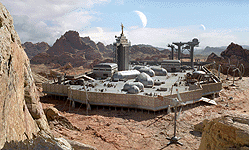
This wide shot of the Mormon compound, part of a FedNet broadcast, is a Compound Eye matte painting, which includes miniature and live action elements.
TROOPERS is easily the biggest project Compound Eye has ever tackled. Working with animator and compositor Rich Cohen, modellers Nick Blake, Elise Robertson, Facundo Rabaudi and Mike Murnane, Sullivan supervised and personally painted 23 digital matte painting shots for the film.
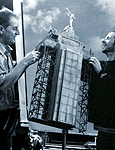
Nick Blake and Mike Murnane of Compound Eye handle a portion of the Mormon miniature.
Various effects that defy categorization were handed to industry veteran Peter Kuran and his company Visual Concept Entertainment (VCE). An alumni of the original STAR WARS, Kuran and VCE's work has been seen in over 200 films. The shots handed to VCE included some complicated digital erasure shots, motion control shots, and digital compositing duties.
Another ambitious motion control shot takes place as Johnny Rico is undergoing his underwater surgery. "The stasis tank was our first underwater motion control shot ever," said Kuran. "Casper Van Dien was immersed in the tank and shot on one motion control pass. Then, a prosthetic leg built by Yagher was placed in the tank and a clean pass was made. These were then digitally combined in the compositing stage."
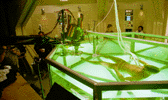
The General Lift motion control rig in action. General Lift's web site has more pics and info.
Although only a few years old, the young company Banned From The Ranch has made a bold statement on the industry by providing solid screen graphics and visual effects to a number of huge motion pictures, including DANTE'S PEAK, SPAWN and the upcoming TITANIC. BFTR was brought on to create the screen graphics for the film, whose 24 frame video displays were supervised by Video Image. In addition, BFTR supplied the graphics for the FedNet sequences--sequences that mark chapter headings of the film. The FedNet sequences are overt propaganda, designed by the Federation to strengthen the war effort.
Van Ling, founder and creative supervisor of BFTR, talked with me about the challenges of the FedNet sequences: "Paul Verhoeven wanted the graphics to be a cross between the titles included in WWII propaganda films and the titles from b-movie trailers from the 1950's, and to cross that with an internet, point-and-click-type concept." Mark Sullivan, the film's matte painting artist, created a 'Join Up Now' graphic that was enthusiastically approved by Verhoeven, "so he handed that to us and said, this is the kind of thing I want... very metallic, very metal, with a steel, military kind of feeling."
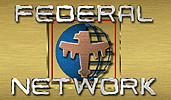
Banned From the Ranch's title FedNet screen.
In most cases, BFTR's graphics were composited over other houses' effects shots, which posed interesting logistical challenges. Production of the FedNet graphics, and the visual effects shots by ILM, VCE, Mark Sullivan and Sony were occurring simultaneously. Ling noted, "We designed the graphics and their placement based on other houses' test comps. That was challenging, since we never really knew what the final image would exactly look like." BFTR shipped many of their completed graphics to the various houses whose shots they would appear in.
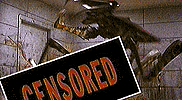
BFTR's graphics, in this case, needed to be composited over Tippett's composite of a Warrior destroying a cow.

Home - Who - Review - How - Pics: Bugs, Space, More

. . VFX HQ Produced by Todd Vaziri . . http://www.vfxhq.com . . e-mail: tvaziri@gmail.com . .
All text Copyright © 1998 Todd Vaziri, unless otherwise noted